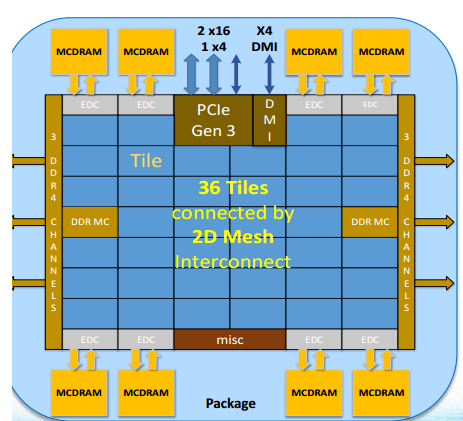- Mark as New
- Bookmark
- Subscribe
- Mute
- Subscribe to RSS Feed
- Permalink
- Report Inappropriate Content

Can I find out the core location in the figure through the core number?
- Mark as New
- Bookmark
- Subscribe
- Mute
- Subscribe to RSS Feed
- Permalink
- Report Inappropriate Content
The detailed mapping depends on the model number and the positions of the tiles with disabled cores....
Using microbenchmarks and performance counters, I worked out the core numbering scheme on a Xeon Phi 7250 processor. The precedure and results are described in https://www.ixpug.org/documents/1524216121knl_skx_topology_coherence_2018-03-23.pptx
Link Copied
- Mark as New
- Bookmark
- Subscribe
- Mute
- Subscribe to RSS Feed
- Permalink
- Report Inappropriate Content
The detailed mapping depends on the model number and the positions of the tiles with disabled cores....
Using microbenchmarks and performance counters, I worked out the core numbering scheme on a Xeon Phi 7250 processor. The precedure and results are described in https://www.ixpug.org/documents/1524216121knl_skx_topology_coherence_2018-03-23.pptx
- Mark as New
- Bookmark
- Subscribe
- Mute
- Subscribe to RSS Feed
- Permalink
- Report Inappropriate Content
Oh! Thank you. I need core information of Xeon Phi 7250 processor.
- Mark as New
- Bookmark
- Subscribe
- Mute
- Subscribe to RSS Feed
- Permalink
- Report Inappropriate Content
The first piece of good news is that all 38 Coherence & Home Agents (CHAs) are active on the Xeon Phi 7250, so their numbering is fixed. These are the "tile" numbers on slide 21 of my presentation.
- I can't guarantee that the numbering is the same for products from different vendors, because the BIOS is involved in some of the numbering/mapping algorithms.
- I can't guarantee that the numbering won't change if you reboot in a different mode (flat/hemisphere/quadrant/SNC2/SNC4).
- But for a fixed vendor and fixed mode, the numbering of the CHAs should be the same across all nodes and should be persistent across reboots.
The second piece of good news is that the core APIC IDs are not renumbered on KNL to skip over disabled cores. This is described on slides 19, 43-44 of my IXPUG presentation linked above. So you will be able to figure out which physical cores are disabled by seeing which core APIC IDs don't show up in the output of the CPUID instruction as described on slide 43. (I typically use the command-line cpuid tool from http://www.etallen.com/cpuid.html to collect this data.)
There are many possible patterns of disabled cores in the Xeon Phi 7250, which has 8 cores disabled (both cores on each of 4 tiles). In order to support SNC2 and SNC4 mode, Intel limits the patterns of disabled cores to maintain some level of symmetry, but there are still a stupid number of possibilities -- something like 10 possible tiles in the 1st quadrant * 10 possible tiles in the second quadrant * 9 possible tiles in the third quadrant * 9 possible tiles in the fourth quadrant = 8100 possible patterns. (This is just an estimate -- I don't actually know the symmetry rules that Intel applies.) In a set of 458 of our 4200 KNL nodes, I found that
- 121 nodes share the most common pattern
- 183 nodes have unique patterns
- 154 nodes have patterns that are repeated on 2-11 nodes
The bad news is that my data was collected almost exclusively on nodes from one vendor and all booted in "Cache-Quadrant" mode, so you will need to repeat at least part of the analysis that I briefly describe on slides 43-44 to see if your nodes show similar patterns.
- Subscribe to RSS Feed
- Mark Topic as New
- Mark Topic as Read
- Float this Topic for Current User
- Bookmark
- Subscribe
- Printer Friendly Page